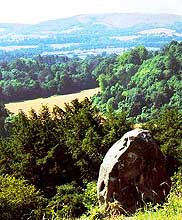|
One of Hampshire's most beautiful woodland areas, where the poet Edward Thomas and his wife Helen lived before his death in the First World War. 323 acres of woodland and beech hanger, with magnificent views over the surrounding area. The nearest town is Petersfield, but roads to Alton and to Liss form part of the road boundary of the area, to which the name Ashford Chase is conveniently given, though in fact it is made up of a series of hills running east from Stoner to Wheatham. Footpaths cross the area from almost every direction. The scenery is outstanding, and has given the name "Little Switzerland" to this part of Hampshire. 
The rise and fall of the landscape and its silhouette on the skyline is made even more impressive by the fact that most of the area is covered in trees, many of them magnificent beeches. In the late 1950's there were proposals to cut down the trees. As a result of this threat to amenity and a wide local appeal, the Petersfield Society was able to buy some £3,000 worth of trees in the area, and the County Council bought the land from just above Stoner going eastwards to Wheatham. Many of the most beautiful trees on either side of the road to Stoner were saved, as well as many trees in other parts of the area, especially those on the skyline. Soon after, in 1964, other woodlands, The Warren and Happersnapper Hanger to the north were also acquired. The whole area of the East Hampshire Hangers, part of an Area of Outstanding Natural Beauty, has been managed most carefully, and new beech trees have been planted.
On Shoulder-of-Mutton Hill there is a plaque to the writer Edward Thomas, killed at Arras in 1917. London born, he loved the hills of Hampshire and in this part of his adopted county it is indeed hard not to share what has been called his "impassioned, almost trance-like delight in things natural."
The East Hampshire Hangers landscape and project
The East Hampshire Hangers landscape is an assemblage of woodland and other habitats which cling to the steep slopes of the chalk and upper greensand scarps around Selborne. This distinctive landscape stretches sinuously from Langrish to the west of Petersfield, through Hawkley and Selborne and on to Binsted, a distance of about 16 miles as the crow flies.
The name 'Hanger' comes from the Old English 'hangra' meaning a wooded slope. The Hangers on the chalk have a dramatic effect on landscape, those on the greensand are less imposing but they make an important contribution to the wooded character of the area. Most of the Hangers lie within an Area of Outstanding Natural Beauty and have important historical connections with the 18th century naturalist Gilbert White, and the poet Edward Thomas. Many of the woods have been designated Sites of Special Scientific Interest, or are Local Nature Reserves.
The Project was set up in response to concern at the deterioration of the Hanger landscape and its habitats through the decline in management. Loss of markets for small woodland produce, particularly hazel coppice, coupled with the inaccessibility of many of the woods, has led to their becoming uneconomic to manage. There are some 185 individual Hangers, covering nearly 800 hectares, under 65 separate ownerships. These range in size from 141 hectares owned by the County Council to several of one hectare. There are a number of small areas of relict chalk grassland - an increasingly rare habitat - although most of these have been invaded by scrub.
The hangers are of international importance for their ecology and safeguarding this for future generations is of paramount importance. Many populations of rare and uncommon plants and insects have declined through the neglect of the woodland. Practical management work such as light thinning, clearance of some of the scrub and re-coppicing of the hazel has improved the wildlife habitats and encouraged natural regeneration of native trees. It also allowed grazing to be resumed on old grassland sites. The Project showed that conservation and small-scale forestry can go hand-in-hand, and that income from forest produce together with grant-aid can support the continued management of the landscape.
Much of the forestry work was carried out by local contractors under the guidance of the Project Officer, and a team of conservation volunteers was established by the Project to carry out small-scale schemes. Specialists, under contract to the Project, have carried out detailed biological assessments of flowering plants, mosses, molluscs, insects and birds, and these have identified the importance of the habitats and provided a basis for future management proposals.
Access to the Hangers by road is not easy, but there is a fine network of footpaths and tracks and the area is popular with walkers for its scenery and natural history. The Hangers Way is a through route promoted by the County Council linking Petersfield, Selborne and Alton.
The Project ended in March 1990. However the work encouraged and developed by the Project Officer has been continued by aware and interested woodland owners who individually and collectively are now promoting sympathetic management. They do so with the continuing help and advice of the authorities responsible for woodland management, countryside and nature conservation. By joint effort, the woodland owners can enhance their opportunities to take advantage of the resources and markets necessary for the long term well-being of the Hangers. |


